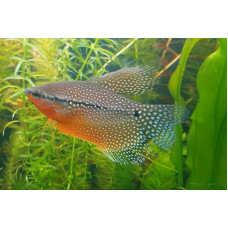Latin name
Trichopodus leerii
Other name
Lace gourami, mosaic gourami.
Identification
The Pearl gourami has an elongated, oval-shaped body that is strongly compressed laterally.
Features of fish fins
These fish have large dorsal and anal fins. The dorsal fin of the male is elongated and significantly extended, coming to a pointed tip. In females, it is much shorter and rounded. The pelvic fins are long and thread-like, extended into thin filaments that the fish often use like antennae to feel objects in front of them.
Fish colouring
The body has a general silvery-violet background covered with pearly, iridescent spots. The two branchiostegal membranes, the dorsal fin, and the caudal fin appear delicate, like lace, and share the same pearly luster as the body. During spawning, the violet color deepens, and the pearly spots become intensely bright, appearing to "glow." Males exhibit a bright orange throat and chest area, with a coffee-brown back. When spawning, the lower part of the gill covers, the entire chest, and the anal fin up to the caudal peduncle turn a vivid red. A dark horizontal stripe runs from the head to the base of the caudal fin. Females are more uniformly and less vividly colored than males, and are somewhat stockier.
Distribution
It inhabits India, the Malay Archipelago, Indonesia (Sumatra and Borneo), and Thailand.
Habitat
They live in shallow, densely vegetated water bodies.
Size
Males of this species reach about 11 cm in length, while females are smaller. In aquarium conditions, they typically do not exceed 8-10 cm in length.
Behavior
Pearl gouramis are very timid and more sensitive to temperature changes and water pollution than the Three Spot gourami. They possess an interesting adaptation—a special organ called the "labyrinth" due to its complex structure, which allows them to breathe atmospheric air. Like all fish, Pearl gouramis have normal gills, but these serve a secondary function. If denied access to the water's surface for an extended period, they will suffocate and die.
Food and feeding habits
Omnivorous. In the wild, they feed on small insects, larvae, worms, algae, and plant detritus.
Reproduction
Hobbyists have successfully crossbred male Pearl gouramis with female Blue gouramis. The hybrids have a bluish body background covered in white spots lacking the pearly iridescence. The anal fin is speckled with bright orange spots, and the caudal fin with white spots. This hybrid is of decorative interest.
Fishing
The Pearl gourami is of commercial interest as a popular aquarium species.
Relationship with people
These fish are peaceful but have specific care requirements that need to be considered.
| Classification | |
| Phylum | Chordata |
| Class | Actinopterygii |
| Squad | Anabantiformes |
| Family | Osphronemidae |
| Genus | Trichopodus |
| Species | T. leerii |
| Features | |
| Conservation status | Near Threatened |
| Habitat | Pelagic |
| Life span, years | No information |
| Maximum body weight, kg | No information |
| Maximum length, cm | 11 |
| Sailing speed, m/s | No information |
| Threat to people | Not edible |
| Way of eating | Omnivore |
Pearl gourami
Tags: pearl gourami


